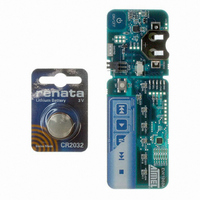EVK1060A Atmel, EVK1060A Datasheet - Page 10

EVK1060A
Manufacturer Part Number
EVK1060A
Description
KIT EVAL FOR AT42QT1060-MMU
Manufacturer
Atmel
Series
Quantum, QTouch™r
Specifications of EVK1060A
Sensor Type
Touch, Capacitive
Sensing Range
1 Button/Key
Interface
I²C
Sensitivity
2mm ~ 5mm Pad Widths
Voltage - Supply
3V
Embedded
No
Utilized Ic / Part
AT42QT1060
Silicon Manufacturer
Atmel
Silicon Core Number
AT42QT1060-MMU
Kit Application Type
Sensing - Touch / Proximity
Application Sub Type
Capacitive Touch
Silicon Family Name
QT1060
Rohs Compliant
Yes
Lead Free Status / RoHS Status
Lead free / RoHS Compliant
3.3
3.4
3.5
10
LED Traces and Other Switching Signals
PCB Cleanliness
Power Supply
AT42QT1060
Digital switching signals near the sense lines induce transients into the acquired signals,
deteriorating the SNR performance of the device. Such signals should be routed away from the
sensing traces and electrodes, or the design should be such that these lines are not switched
during the course of signal acquisition (bursts).
LED terminals which are multiplexed or switched into a floating state, and which are within, or
physically very near, a key (even if on another nearby PCB) should be bypassed to either Vss or
Vdd with at least a 10 nF capacitor. This is to suppress capacitive coupling effects which can
induce false signal shifts. The bypass capacitor does not need to be next to the LED, in fact it
can be quite distant. The bypass capacitor is noncritical and can be of any type.
LED terminals which are constantly connected to Vss or Vdd do not need further bypassing.
All capacitive sensors should be treated as highly sensitive circuits which can be influenced by
stray conductive leakage paths. QT devices have a basic resolution in the femtofarad range; in
this region, there is no such thing as “no clean flux”. Flux absorbs moisture and becomes
conductive between solder joints, causing signal drift and resultant false detections or transient
losses of sensitivity or instability. Conformal coatings trap in existing amounts of moisture which
then become highly temperature sensitive.
The designer should specify ultrasonic cleaning as part of the manufacturing process, and in
cases where a high level of humidity is anticipated, the use of conformal coatings after cleaning
to keep out moisture.
See
with temperature, the device tracks and compensates for these changes automatically with only
minor changes in sensitivity. If the supply voltage drifts or shifts quickly, the drift compensation
mechanism is not able to keep up, causing sensitivity anomalies or false detections.
The usual power supply considerations with QT parts apply to the device. The power should be
clean and come from a separate regulator if possible. However, this device is designed to
minimize the effects of unstable power, and except in extreme conditions should not require a
separate Low Dropout (LDO) regulator.
See underneath
It is assumed that a larger bypass capacitor (like1 µF) is somewhere else in the power circuit; for
example, near the regulator.
To assist with transient regulator stability problems, the QT1060 waits 500 µs any time it wakes
up from a sleep state (i.e. in SLEEP and LP modes) before acquiring, to allow Vdd to fully
stabilize.
Section 8.2 on page 26
close to the power pins of the IC. Failure to do so can result in device oscillation,
high current consumption, erratic operation etc.
Caution: A regulator IC shared with other logic can result in erratic operation and is
not advised.
A single ceramic 0.1 µF bypass capacitor, with short traces, should be placed very
Figure 1-1 on page 4
for the power supply range. If the power supply fluctuates slowly
for suggested regulator manufacturers.
9505E–AT42–02/09












